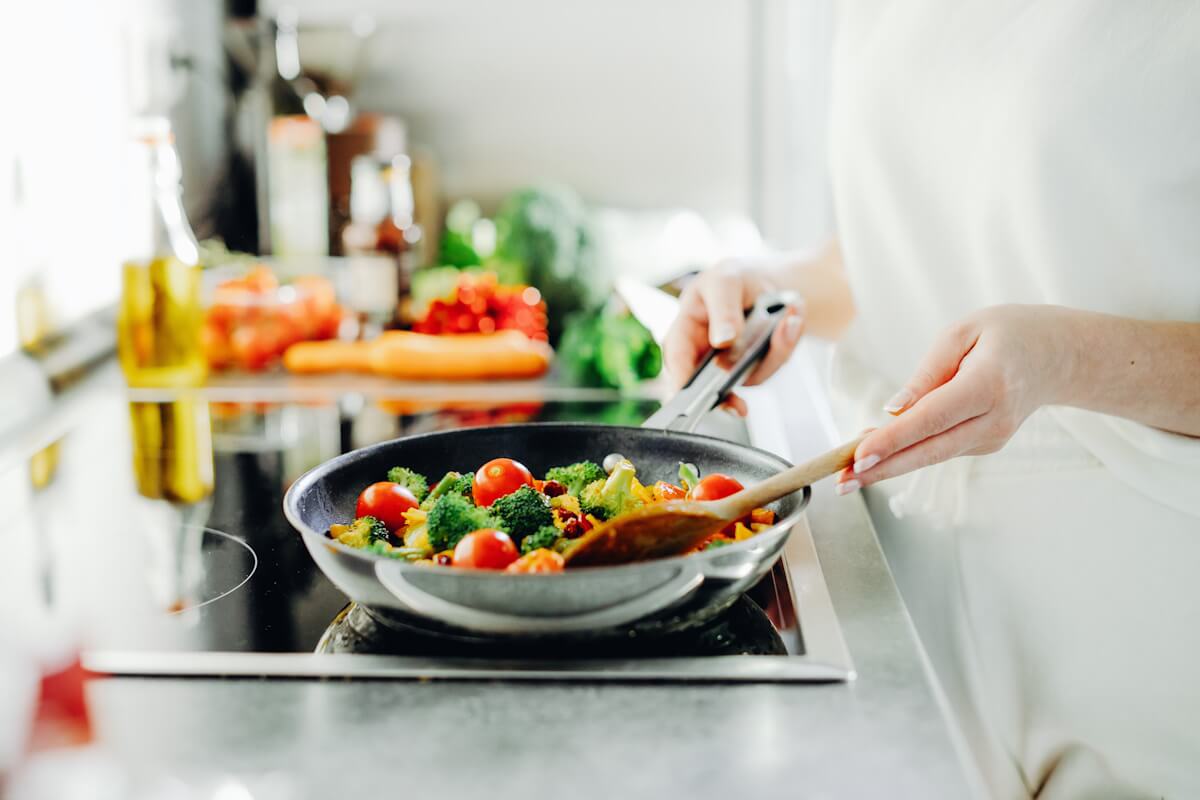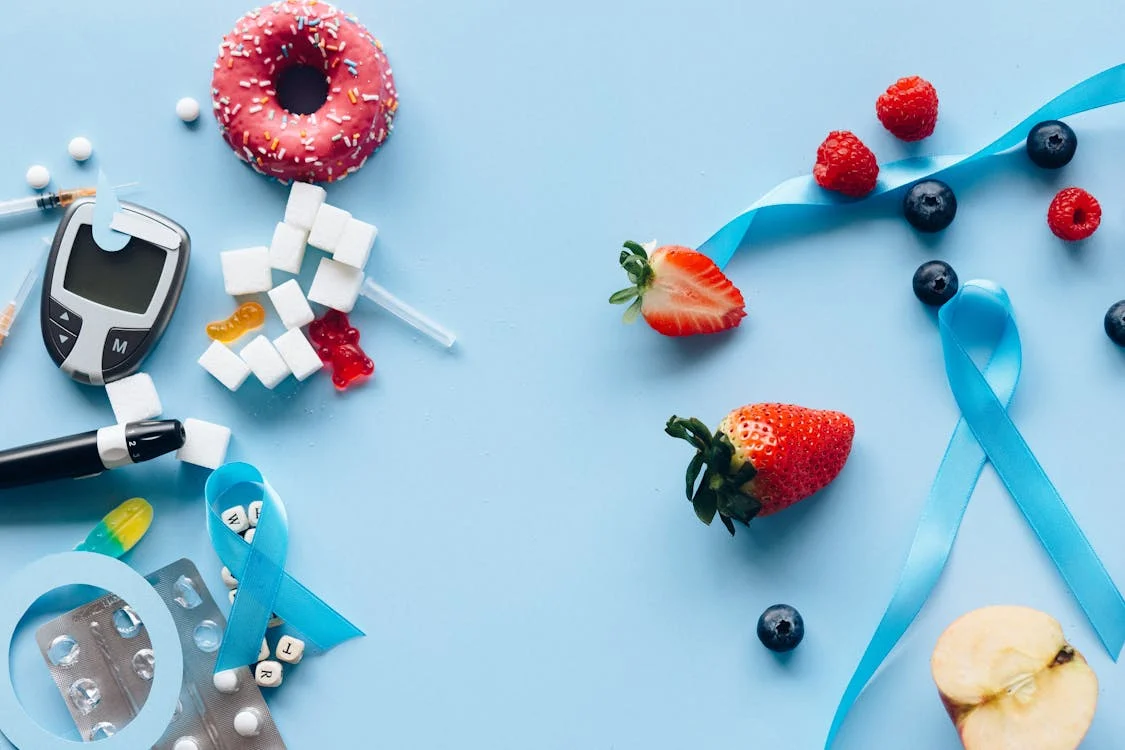If you’re someone who’s always looking for ways to improve your health while still enjoying a wide variety of delicious foods (like me), then you’ve probably heard of cooking without oil.
At first, cooking without oil can seem like a baffling choice.
How will you brown your food and stop it from sticking to the pan?
Does food made without oil even taste cooked anymore?
I was skeptical, too, at first. But, there are many ways to make fantastic and rich-tasting foods without reaching for the nearest bottle of olive or sesame oil. Plus, cooking without added oils helps cut calories out of your favorite foods.
It’s also much better for your heart. Oil-less cooking, even part-time, can help prevent heart disease from developing or progressing.
With all those benefits in mind, I thought it was worth looking into oil-free cooking a little more closely. Plus, I put this guide together so you can learn with me!
In this guide, I’ll discuss:
- Why you should consider cooking without oil.
- How to cook without oil or butter.
- How to add flavor and moisture to your favorite foods without adding oil.
- And much more!
Why Cook Without Oil?
There are a lot of reasons people consider cooking without oil. After all, cutting oil out of your diet means one less thing to buy at the grocery store.
Some people cut oil because they are concerned about the environmental impact of oil production. Palm oil, for example, is a very productive crop. Unfortunately, but it is a major driver of deforestation of some of the world’s most biodiverse forests.
The most common reason, though, is that cutting oil can have a lot of health benefits.
Why is oil such a health problem?
There are two core reasons:
Within an hour of eating oil, your arteries’ ability to dilate is reduced, which can translate to long-term circulatory damage over a lifetime. Especially a lifetime of high-oil consumption.
The other reason is that all oils are high-calorie and low-nutrient foods. Sure, some oils like olive oil have some nutrient value, but that nutrient content is still incredibly low compared to the caloric content.
Why are the nutrients so low?
Because making oil inherently strips the naturally occurring fats (oils) away from the other nutrients in the source. So, olive oil has a very small amount of the nutrients, and almost none of the carbs, proteins, or fiber found in a whole olive.
The same is true for coconut oil, palm oil, canola oil, and all the rest.
Now, I’m not saying you should cut all of the fat out of your diet for a lower-caloric intake. Your body needs dietary fat to function properly!
The goal of oil-free cooking is simply to eliminate the unnecessary oils.
Without those oils in your diet, you can incorporate more sources of healthy fats that still have the other nutrients.
Oils and fats also make you fill up faster. Eliminating excess cooking oils often means that you can eat larger portions (for fewer calories) and increase your nutrient intake.
Sounds like a good deal? Keep reading to learn how to cook without oil or butter.
Try an Air Fryer
The easiest way to cook with less or no oil at all is by using an air fryer or an air fryer toaster oven.
In it, you can cook most foods you would deep fry, like chicken wings, meat cuts, French fries, veggies, and even tofu. Some high-quality appliances bake pizzas, cakes, and cinnamon rolls as well!
My favorite air fryer is the Philips Avance XXL Twin TurboStar. But you can check my reviews of the best air fryers on the market.
- The Philips Airfryer XXL is the healthiest way to fry, using little or no added oil...
- With a 3 pounds/4qt capacity you can now make delicious meals for up to 6 people...
- The air fryer is instantly hot and ready to go in seconds, cooking 4 times faster...
- Multi-cooking technology: Air fry, bake, grill, roast, reheat, dehydrate, and toast,...
- Cleaning is simple: This Philips Airfryer XXL includes dishwasher-safe removable...
It works with just a drop of oil and actually extracts the excess fats and oils that get squeezed out during the cooking process.
It works super fast (doesn’t need any preheating), has dishwasher safe parts, making it easy to clean, and most importantly – it turns anything you put in there into a deliciously crunchy and evenly crispy treat!
Regular Cooking and Frying Without Oil
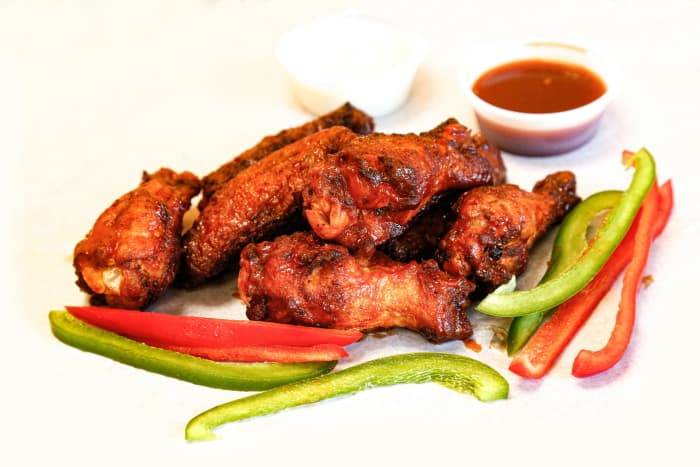
Not everyone wants to invest in a new kitchen appliance, so most people do their cooking on the stovetop, with pots and pans moistened with a little bit of oil in the bottom.
That kind of everyday sautéing and stir-frying is often the biggest barrier to oil-less cooking. Fortunately, the process isn’t that much more difficult. Cooking on your stovetop without oil starts with picking the right kinds of pots and pans!
What Kind of Pots and Pans Should I Use?
Your pots and pans can make the difference between success and failure, especially when you’re first starting to cook without oil.
The best pans for oil-less cooking are pans that are naturally fairly non-stick. That can mean traditional non-stick Teflon pans or several alternatives:
- Thick bottomed stainless-steel pans
- Pre-seasoned cast iron (needs a little more maintenance, and you’ll need some oil to re-season it)
- Enameled cast iron
- Enameled copper
- Copper ceramic
You’re looking for pots and pans with a good non-porous surface that reduces food sticking even without fats or liquids in the pan. They make oil-free cooking a lot easier.
But, if you don’t have that kind of bakeware, don’t despair. You can still switch to oil-free cooking with other kinds of cookware. It’ll just take a little more work.
Sauteing and Frying Food Without Oil
Once you have appropriate cookware, you need to know what to replace your favorite cooking oil with. Oil-free cooking isn’t as simple as cooking all of your foods without oil. You still need to add something to your pots and pans to prevent burns and sticking.
The easiest solution?
Add small amounts of liquid that loosens your food, but steams off quickly. There are lots of options for cooking liquids here, so I recommend experimenting until you find your favorites.
It’s also a good idea to match your cooking liquid to the kind of food you’re making. For example, to sauté without oil, add a little water.
You can also consider your cooking liquid an opportunity to add more flavor to your food! Here are some of your options, but don’t feel limited by this list:
- Water
- Water mixed with a small amount of soy sauce
- Coconut aminos
- Apple cider vinegar
- Broth
- Pot liquor (I’ll explain in a moment)
- Any slightly savory, salty, or sweet thin liquid
Pot liquor is often one of the best options but often overlooked.
What is pot liquor?
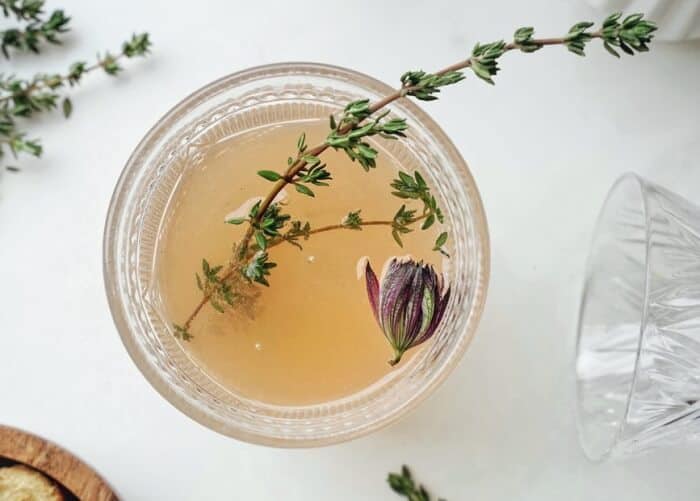
Basically, pot liquor is the leftover liquid from cooking or steaming other foods. Boiling a pot of beans? You likely have a pot full of liquid left over, which can add a ton of natural umami flavor to your cooking.
Steaming broccoli and beets, boiling cauliflower, or even making a delicious herby stock can all result in fantastic cooking liquids you can use to replace cooking oil.
How to use cooking liquids to fry food without oil
Well, you don’t just toss a bunch of liquid in the pan and hope for the best!
Instead, you should gradually add the liquid a couple of teaspoons at a time anytime you need to loosen the food in the pan.
Don’t start with the liquid first, either. Unlike oil, you should start cooking your main ingredients before adding your liquids.
Cook for a minute or two on medium-high heat and then add a little cooking liquid. You want just enough to loosen your food, and it should boil off completely within a couple of minutes.
Accidentally add too much?
Turn up the heat on your stove so that the liquid still steams off within a minute or two, and then turn the temperature back down.
Make sure you’re adding the liquid as you stir, and that you’re stirring a little more often than you normally would. Let your ingredients cook a little longer before adding cooking liquid if you’re looking for more of a browned finish.
Not convinced? I found a great video covering some of the main reasons for switching to cooking without oil, and shows you how to make a few healthy and delicious oil-free dishes.
Enjoy!
Baking Without Oil
I’ve covered cooking without oil, but you can also bake without it.
Now, baking without oil can be more challenging, depending on what you’re making, but it can be done.
Baking vegetables and even meat is usually easier than baking bread and cakes without oil, but not adding any oil doesn’t limit your choices.
Savory Roasting Without Oil
For roasting vegetables and meats, the secret to cooking without oil is to use a little of the same cooking liquids you’d use for stovetop cooking and roasting everything low and slow.
Cooking liquid in a spray bottle gives you an easy way to add a little moisture and flavor to your vegetables and meats, which helps prevent them from drying out. A couple of sprays across the whole baking tray is usually enough.
Of course, using cooking liquids for roasting doesn’t address the problem of sticky messes on your baking pan.
To avoid food getting stuck to the pan, you’re best off with regular parchment paper. Nothing sticks to it, and it won’t crisp or smoke with low and slow roasting.
Bread, Cakes, and Confections Without Oil

This is where cooking without oil gets trickiest. Most baking recipes call for a significant amount of fats in the form of liquid oils, butter, shortening, or lard.
You can’t just omit those oils and still have your baked goods turn out right. Oils are in your baking recipes for a lot of important reasons.
So, the first step to replacing your baking oil is figuring out why the oil is in your recipe in the first place. Here are some common reasons:
- Structure (like in pastry)
- Moisture
- Flavor
- All of the above
Knowing why the oil is in your baked goods will help you make a reasonable substitute. It’s hard to replace the butter in pastries, but substitutions are possible for most other baked goods.
Here are some good options:
- Applesauce (adds moisture and flavor)
- Yogurt (moisture, flavor, and adds healthy fats)
- Nut butter (flavor, structure, moisture, and healthy fats)
- Sweet potato and squash purees
- Mashed bananas
- Mashed or pureed dates
- Pureed prunes
Unfortunately, matching the right oil-replacement to your recipe is more of an art than a science. Some recipes will give you the amount of yogurt to replace oil with, but it’s still uncommon.
The other challenge is that the ratio of oil to the replacement substance isn’t 1:1. You may need more or less of it, and the amount will vary depending on the alternative and what it is you’re baking.
Finding the right replacements and ratios involves some trial and error, but you’ll have healthier (and often tastier) baked goods when you’re done!
Here’s a quick and easy chocolate cupcake recipe to help you get started. (Bonus! This recipe gets its sweetness from naturally occurring sugars in dates, and is gluten-free and vegan as well.)
Oil-Free Bakeware
The last thing I want to touch on is bakeware. When you don’t want to butter or oil your bakeware, it can be a little bit trickier to find good options that don’t let your food stick.
For some things like bread, you can use traditional bakeware with a corn flour layer to prevent sticking. If you don’t like the idea of gritty corn flour on the bottom of your cupcakes, layer the tray with muffin liners first.
Parchment paper is also a good option, but it isn’t always practical, especially for shaped goods like Bundt cakes.
So, instead of using traditional metal pans, oil-free baking calls for silicone bakeware. Silicone bakeware doesn’t stick to your food and is more flexible, making freeing baked goods a lot easier.
However, you do need to adjust your baking time when you use silicone trays. Silicone doesn’t transfer heat as well as metal baking pans, so it will take 2-6 minutes longer to bake most recipes.
My Final Thoughts on Cooking Without Oil
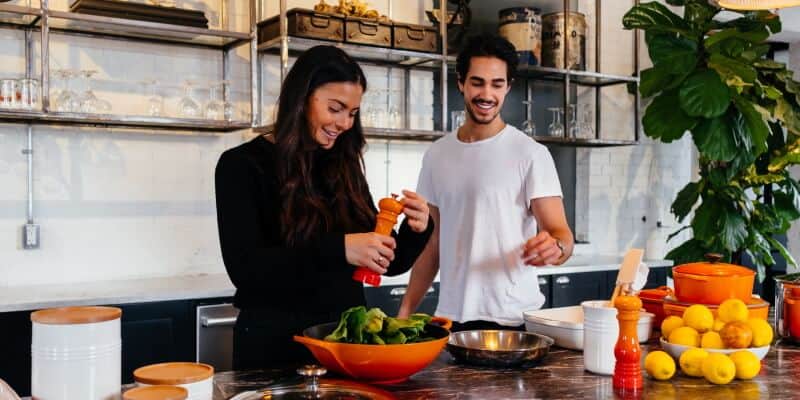
Oil-less cooking is just another way of adapting your diet to meet your health goals. It’s not very different from adjusting your cooking for a food allergy or sensitivity, but that doesn’t mean that it isn’t an adjustment.
Some people can dive right into no-oil cooking and never look back, but it can be more of a challenge for others.
My recommendation?
Treat it like any other major change in your life and give yourself some time to get used to it and accept cooking without oil as your new norm.
It’s okay if you can’t bring yourself to give up oil right away. It’s okay if you only make oil-free meals a couple of times a week.
Most importantly, it’s okay if this isn’t the right change for you, or if you land on part-time oil-free as the best choice for you and your family.
There’s just one thing left.
Happy experimenting, and I hope you enjoy your new, healthier meals!
FAQ
Is it possible to cook without oil?
Absolutely, you can cook without oil! Steaming, boiling, and baking are great methods. You can also use broth, water, or juice for sautéing and stir-frying. Cooking without oil is not only possible but also can make meals lighter and healthier.
Is it healthier to cook without oil?
Cooking without oil is often healthier. It cuts down on added fats and calories. Also, it’s a good choice for people watching their cholesterol or fat intake. But remember, some fats are healthy, so balance is key.
Is cooking without oil bad for pan?
Nope, cooking without oil won’t ruin your pan if you take care. Non-stick pans and cast-iron skillets are best for this. Just keep the heat low to medium, and you’re good to go.
What food can I make without oil?
You can make a ton of tasty food without oil. Think steamed veggies, grilled chicken, or baked fish. Even desserts like fruit sorbet! As a foodie, I love experimenting with oil-free recipes, and trust me, they’re delicious!
